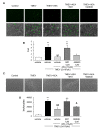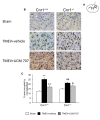Anandamide inhibits Theiler's virus induced VCAM-1 in brain endothelial cells and reduces leukocyte transmigration in a model of blood brain barrier by activation of CB(1) receptors
- PMID: 21851608
- PMCID: PMC3173342
- DOI: 10.1186/1742-2094-8-102
Anandamide inhibits Theiler's virus induced VCAM-1 in brain endothelial cells and reduces leukocyte transmigration in a model of blood brain barrier by activation of CB(1) receptors
Abstract
Background: VCAM-1 represents one of the most important adhesion molecule involved in the transmigration of blood leukocytes across the blood-brain barrier (BBB) that is an essential step in the pathogenesis of MS. Several evidences have suggested the potential therapeutic value of cannabinoids (CBs) in the treatment of MS and their experimental models. However, the effects of endocannabinoids on VCAM-1 regulation are poorly understood. In the present study we investigated the effects of anandamide (AEA) in the regulation of VCAM-1 expression induced by Theiler's virus (TMEV) infection of brain endothelial cells using in vitro and in vivo approaches.
Methods: i) in vitro: VCAM-1 was measured by ELISA in supernatants of brain endothelial cells infected with TMEV and subjected to AEA and/or cannabinoid receptors antagonist treatment. To evaluate the functional effect of VCAM-1 modulation we developed a blood brain barrier model based on a system of astrocytes and brain endothelial cells co-culture. ii) in vivo: CB(1) receptor deficient mice (Cnr1(-/-)) infected with TMEV were treated with the AEA uptake inhibitor UCM-707 for three days. VCAM-1 expression and microglial reactivity were evaluated by immunohistochemistry.
Results: Anandamide-induced inhibition of VCAM-1 expression in brain endothelial cell cultures was mediated by activation of CB(1) receptors. The study of leukocyte transmigration confirmed the functional relevance of VCAM-1 inhibition by AEA. In vivo approaches also showed that the inhibition of AEA uptake reduced the expression of brain VCAM-1 in response to TMEV infection. Although a decreased expression of VCAM-1 by UCM-707 was observed in both, wild type and CB(1) receptor deficient mice (Cnr1(-/-)), the magnitude of VCAM-1 inhibition was significantly higher in the wild type mice. Interestingly, Cnr1(-/-) mice showed enhanced microglial reactivity and VCAM-1 expression following TMEV infection, indicating that the lack of CB(1) receptor exacerbated neuroinflammation.
Conclusions: Our results suggest that CB(1) receptor dependent VCAM-1 inhibition is a novel mechanism for AEA-reduced leukocyte transmigration and contribute to a better understanding of the mechanisms underlying the beneficial role of endocannabinoid system in the Theiler's virus model of MS.
Figures





Similar articles
-
The endocannabinoid anandamide downregulates IL-23 and IL-12 subunits in a viral model of multiple sclerosis: evidence for a cross-talk between IL-12p70/IL-23 axis and IL-10 in microglial cells.Brain Behav Immun. 2011 May;25(4):736-49. doi: 10.1016/j.bbi.2011.01.020. Epub 2011 Feb 16. Brain Behav Immun. 2011. PMID: 21310228
-
The synthetic cannabinoid WIN 55,212-2 increases COX-2 expression and PGE2 release in murine brain-derived endothelial cells following Theiler's virus infection.Biochem Pharmacol. 2006 Sep 28;72(7):869-80. doi: 10.1016/j.bcp.2006.06.037. Epub 2006 Aug 17. Biochem Pharmacol. 2006. PMID: 16914119
-
Anandamide Inhibits Vascular Smooth Muscle Migration, Endothelial Adhesion Protein Expression and Monocyte Adhesion of Human Coronary Artery Cells.Cells. 2024 Dec 19;13(24):2108. doi: 10.3390/cells13242108. Cells. 2024. PMID: 39768198 Free PMC article.
-
Functions of the CB1 and CB 2 receptors in neuroprotection at the level of the blood-brain barrier.Neuromolecular Med. 2014 Sep;16(3):620-42. doi: 10.1007/s12017-014-8314-x. Epub 2014 Jun 15. Neuromolecular Med. 2014. PMID: 24929655 Review.
-
Hydrogen peroxide activation of endothelial cell-associated MMPs during VCAM-1-dependent leukocyte migration.Cell Mol Biol (Noisy-le-grand). 2006 Dec 31;52(4):8-16. Cell Mol Biol (Noisy-le-grand). 2006. PMID: 17543193 Free PMC article. Review.
Cited by
-
Cannabinoid Signaling and Neuroinflammatory Diseases: A Melting pot for the Regulation of Brain Immune Responses.J Neuroimmune Pharmacol. 2015 Jun;10(2):268-80. doi: 10.1007/s11481-015-9584-2. Epub 2015 Jan 20. J Neuroimmune Pharmacol. 2015. PMID: 25601726 Review.
-
Stem Cells as a Promising Tool for the Restoration of Brain Neurovascular Unit and Angiogenic Orientation.Mol Neurobiol. 2017 Dec;54(10):7689-7705. doi: 10.1007/s12035-016-0286-4. Epub 2016 Nov 14. Mol Neurobiol. 2017. PMID: 27844280 Review.
-
Alterations of the blood-brain barrier during aging.J Cereb Blood Flow Metab. 2024 Jun;44(6):881-895. doi: 10.1177/0271678X241240843. Epub 2024 Mar 21. J Cereb Blood Flow Metab. 2024. PMID: 38513138 Free PMC article. Review.
-
Anti-Inflammatory Effects of Cannabinoids in Therapy of Neurodegenerative Disorders and Inflammatory Diseases of the CNS.Int J Mol Sci. 2025 Jul 8;26(14):6570. doi: 10.3390/ijms26146570. Int J Mol Sci. 2025. PMID: 40724820 Free PMC article. Review.
-
Chromenopyrazole, a Versatile Cannabinoid Scaffold with in Vivo Activity in a Model of Multiple Sclerosis.J Med Chem. 2016 Jul 28;59(14):6753-6771. doi: 10.1021/acs.jmedchem.6b00397. Epub 2016 Jul 6. J Med Chem. 2016. PMID: 27309150 Free PMC article.
References
-
- Brosnan CF, Cannella B, Battistini L, Raine CS. Cytokine localization in multiple sclerosis lesions: correlation with adhesion molecule expression and reactive nitrogen species. Neurology. 1995;45:S16–S21. - PubMed
Publication types
MeSH terms
Substances
LinkOut - more resources
Full Text Sources
Miscellaneous

